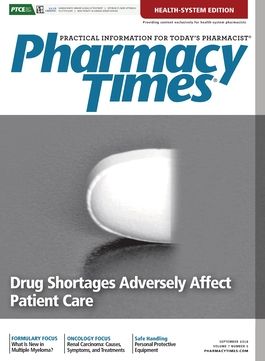Publication
Article
Pharmacy Practice in Focus: Health Systems
USP Chapter : Personal Protective Equipment
Author(s):
United States Pharmacopeial Convention (USP) Chapter has many prerequisites for personal protective equipment
United States Pharmacopeia (USP) Chapter <800> has many prerequisites for personal protective equipment. These are detailed in section 7. The intent of this section is to provide “worker protection to reduce exposure to hazardous drug (HD) aerosols and residues.” The National Institute for Occupational Safety and Health uses 6 criteria to identify an HD: carcinogenicity; drugs that mimic existing drugs in structure or toxicity; genotoxicity; organ toxicity at low doses; reproductive toxicity; teratogenicity. Below is an overview of the requirements for personal protective equipment (PPE) in nonsterile HD compounding in the HD compounding area, also known as the compounding secondary engineering control (C-SEC), found in USP Chapter <800>. PPE must be worn in the C-SEC when handling HDs. According to the introduction of section 7 of USP Chapter <800>, appropriate PPE must be worn when handling HDs, including during receipt; storage; transport; compounding (both nonsterile and sterile); administration, deactivation/decontamination, cleaning, and disinfecting; spill control; and waste disposal.
Compounding pharmacies need to be familiar with the requirements for PPE and have appropriate policies and procedures to protect workers. This is a significant challenge that takes a large amount of time to evaluate and implement. A summary of each subsection of section 7 follows.
Section 7.1: Gloves
Gloves used for HD compounding must be chemotherapy gloves that meet the American Society for Testing Materials standard D6978. The introduction of section 7 notes that 2
pairs of chemotherapy gloves are required.
In our pharmacy, we have implemented this requirement and are using gloves that are comfortable and affordable. Gloves should be changed every 30 minutes when contaminated, punctured, or torn, unless the manufacturer has documentation allowing for longer use. This may include the need to change gloves between different preparations. A best practice when donning gloves is to wear the first pair under the gown cuff and the second over the gown cuff.
Section 7.2: Gowns
Gowns need to “be disposable and shown to resist permeability by HDs.” Polyethylene-coated
polypropylene gowns are 1 choice referenced in the chapter. The gowns must open in the back,
be long sleeved, and have a closed elastic or knit cuff. In the absence of manufacturer’s guidance on permeation, the gown must be changed every 2 to 3 hours or sooner if contaminated.
Section 7.3: Head, Hair, Shoe, and Sleeve Covers
Beard, hair, head, and mustache covers are required when compounding HDs. The
chapter is not specific about whether to don these covers before entering the C-SEC. The intent is to “provide protection from contact with HD residue.” Two pairs of shoe covers must be worn when compounding HDs. The second pair must be donned before entering the C-SEC. Shoe covers must be removed and discarded upon exiting the C-SEC.
Section 7.4: Eye and Face Protection
Eyes and mucous membranes must be protected from exposure to HDs. Goggles are required when there is a risk of spills or splashes of HDs. Safety glasses with side shields are not acceptable. USP <800> does not specifically address eye and face protection for those working in a compounding primary engineering control (C-PEC). A C-PEC is commonly referred to as a powder hood or a ventilated enclosure.
Section 7.5: Respiratory Protection
In most instances, an N95 surgical respirator mask, which protects against airborne particles, must be worn. The mask must be fit-tested. A surgical mask does not provide respiratory protection and is not acceptable for HD compounding. The N95 mask protects against drops, splashes, and sprays around the mouth and nose.
When unpacking HDs, an assessment of the packaging material is necessary. If the
container is not plastic and is, for instance, made of glass, the personnel unpacking the container “should wear an elastomeric half-mask with a multi-gas cartridge and P100-filter until assessment of the packaging integrity can be made to ensure no breakage or spillage occurred during transport.”
Section 7.6: Disposal of Used Personal Protective Equipment
Consider all PPE worn when handling HDs to be contaminated with, at minimum, trace quantities of HDs. It is very important that compounding pharmacies understand this and have policies that reflect appropriate disposal of worn PPE.
Conclusion
USP Chapter <800> is clear in many portions. However, other areas are open to interpretation. It is important that compounders make informed decisions during the planning and implementation of the chapter.
Douglas C. Higgins, RPh, FIACP, is the owner of Doug’s Compounding Pharmacy in Paxton, Illinois.







